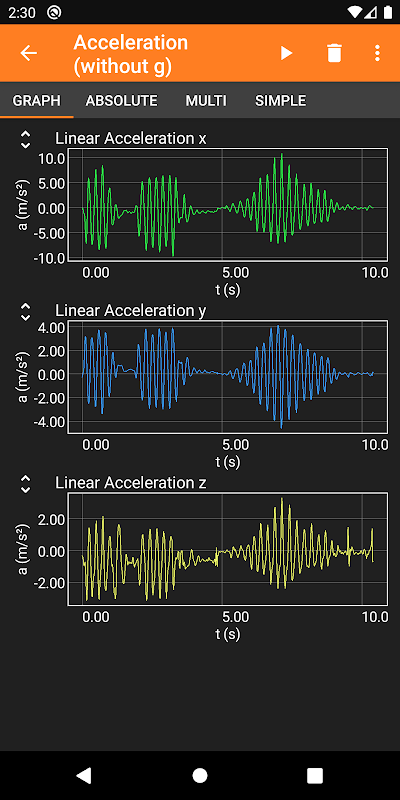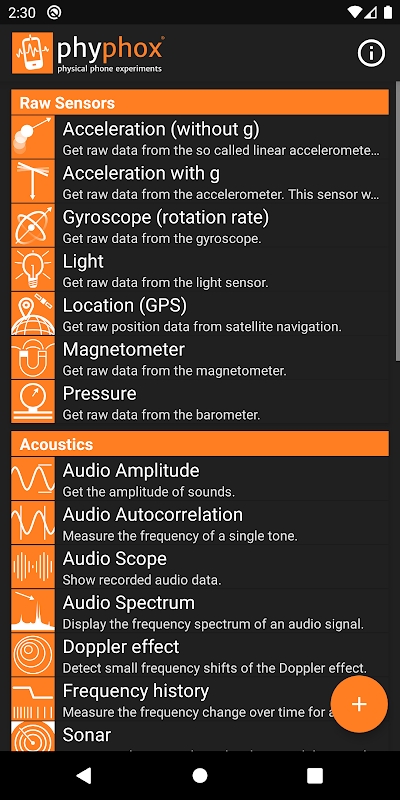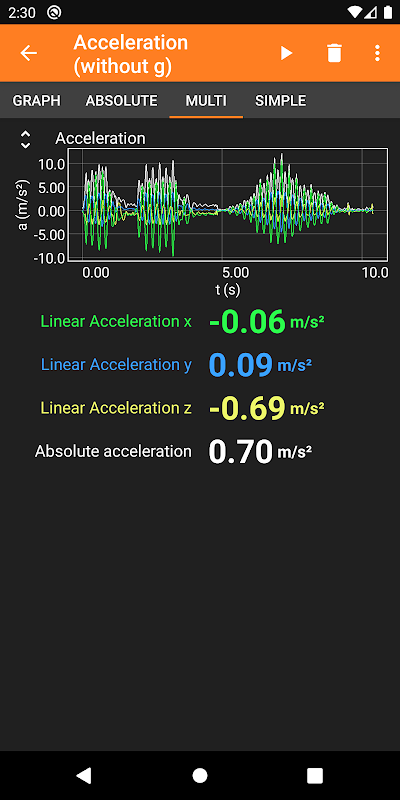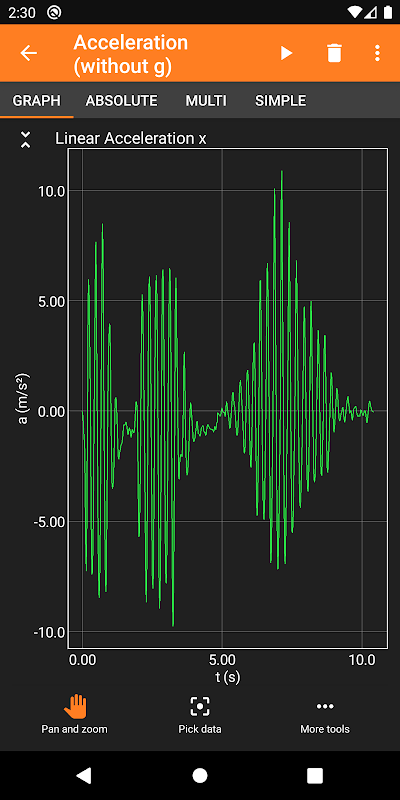Did you know that you are carrying a 3D magnetometer? That you can use your phone as a pendulum to measure earth's local gravitational acceleration? That you can turn your phone into a sonar?
phyphox gives you access to the sensors of your phone either directly or through ready-to-play experiments which analyze your data and let you export raw data along with the results for further analysis. You can even define your own experiments on phyphox.org and share them with colleagues, students and friends.
Selected Features:
- A selection of pre-defined experiments. Just press play to start.
- Export your data to a range of widely used formats
- Remote-control your experiment through a web interface from any PC on the same network as your phone. No need to install anything on those PCs - all you need is a modern web browser.
- Define your own experiments by selecting sensor inputs, defining analysis steps and creating views as an interface using our web-editor (http://phyphox.org/editor). The analysis can consists of just adding two values or using advanced methods like Fourier transforms and crosscorrelation. We offer a whole toolbox of analysis functions.
Sensors supported:
- Accelerometer
- Magnetometer
- Gyroscope
- Light intensity
- Pressure
- Microphone
- Proximity
- GPS
*some sensors are not present on every phone.
Export formats
- CSV (Comma separated values)
- CSV (Tab-separated values)
- Excel
(if you need other formats, please let us know)
This app has been developed at the 2nd Institute of Physics A at the RWTH Aachen University.
--
Explanation for the permissions requested
If you have Android 6.0 or newer, some permissions will only be asked for when needed.
Internet: This grants phyphox network access, which is required to load experiments from online resources or when using the remote access. Both are only done when requested by the user and no other data is transmitted.
Bluetooth: Used to access external sensors.
Read external storage: This is may be necessary when opening an experiment stored on the device.
Record audio: Required to use the microphone in experiments.
Location: Used to access GPS for location-based experiments.
Camera: Used to scan QR codes for external experiment configurations.
Content
PhyPhox, short for Physical Phone Experiments, is a powerful mobile application that transforms smartphones and tablets into versatile physics laboratories. Leveraging the array of built-in sensors found in modern mobile devices, PhyPhox allows users to conduct a wide range of experiments, from measuring acceleration and magnetic fields to analyzing acoustic phenomena and determining the speed of sound. Its intuitive interface and extensive features make it an invaluable tool for students, educators, and anyone with a curiosity for exploring the physical world.
One of PhyPhox's key strengths lies in its accessibility. The app is freely available for both Android and iOS devices, eliminating the need for expensive laboratory equipment and making physics experimentation possible for a broader audience. Its user-friendly design ensures that even those with limited technical expertise can quickly grasp the functionalities and begin conducting experiments. The app's interface is clean and well-organized, presenting users with a clear selection of pre-designed experiments categorized by topic.
The range of experiments available within PhyPhox is impressive, covering various branches of physics. Acceleration experiments allow users to explore the principles of motion, measuring linear acceleration in three dimensions and analyzing oscillations. Gyroscope experiments provide insights into rotational motion, while the magnetometer experiments enable the study of magnetic fields and their interactions. Acoustic experiments utilize the device's microphone to analyze sound waves, determine frequencies, and measure sound intensity. The proximity sensor can be employed to investigate the reflection of light and measure distances. Furthermore, the app allows users to determine the speed of sound using the device's microphone and speaker, providing a practical application of wave physics.
Beyond the pre-designed experiments, PhyPhox offers a remarkable level of customization. Users can create their own experiments by combining different sensor inputs and defining specific analysis methods. This flexibility allows for tailored investigations and encourages creative exploration of physical phenomena. The app supports data logging, enabling users to record measurements over time and export the data for further analysis in external software. This feature is particularly useful for conducting long-term experiments or for detailed data processing.
PhyPhox also fosters collaboration and knowledge sharing. The app allows users to export experiment configurations and share them with others, facilitating the replication of experiments and promoting open scientific practices. This feature is especially beneficial in educational settings, where teachers can share pre-configured experiments with students or students can collaborate on experimental designs.
The app's integration with external hardware further expands its capabilities. PhyPhox supports connections to external sensors via Bluetooth, allowing for the measurement of physical quantities beyond the capabilities of the built-in sensors. This feature opens up possibilities for more advanced experiments and allows users to incorporate specialized sensors into their investigations.
PhyPhox is not just a collection of experiments; it also serves as an educational resource. The app provides detailed explanations of the underlying physics principles for each experiment, enhancing understanding and promoting deeper learning. The clear and concise descriptions help users grasp the theoretical concepts behind the experiments and interpret the results meaningfully.
The app's continuous development and updates ensure that it remains at the forefront of mobile physics experimentation. The developers actively incorporate user feedback and introduce new features, expanding the app's capabilities and addressing evolving technological advancements. This commitment to improvement ensures that PhyPhox remains a valuable tool for both novice and experienced users.
In conclusion, PhyPhox is a remarkable application that democratizes access to physics experimentation. Its intuitive interface, diverse range of experiments, and extensive customization options make it a powerful tool for learning, exploring, and discovering the physical world. Whether used in a classroom setting, for individual exploration, or for advanced research, PhyPhox empowers users to unlock the scientific potential of their mobile devices and engage with physics in an engaging and interactive way. Its accessibility, versatility, and continuous development make it a must-have tool for anyone interested in the wonders of physics.
Did you know that you are carrying a 3D magnetometer? That you can use your phone as a pendulum to measure earth's local gravitational acceleration? That you can turn your phone into a sonar?
phyphox gives you access to the sensors of your phone either directly or through ready-to-play experiments which analyze your data and let you export raw data along with the results for further analysis. You can even define your own experiments on phyphox.org and share them with colleagues, students and friends.
Selected Features:
- A selection of pre-defined experiments. Just press play to start.
- Export your data to a range of widely used formats
- Remote-control your experiment through a web interface from any PC on the same network as your phone. No need to install anything on those PCs - all you need is a modern web browser.
- Define your own experiments by selecting sensor inputs, defining analysis steps and creating views as an interface using our web-editor (http://phyphox.org/editor). The analysis can consists of just adding two values or using advanced methods like Fourier transforms and crosscorrelation. We offer a whole toolbox of analysis functions.
Sensors supported:
- Accelerometer
- Magnetometer
- Gyroscope
- Light intensity
- Pressure
- Microphone
- Proximity
- GPS
*some sensors are not present on every phone.
Export formats
- CSV (Comma separated values)
- CSV (Tab-separated values)
- Excel
(if you need other formats, please let us know)
This app has been developed at the 2nd Institute of Physics A at the RWTH Aachen University.
--
Explanation for the permissions requested
If you have Android 6.0 or newer, some permissions will only be asked for when needed.
Internet: This grants phyphox network access, which is required to load experiments from online resources or when using the remote access. Both are only done when requested by the user and no other data is transmitted.
Bluetooth: Used to access external sensors.
Read external storage: This is may be necessary when opening an experiment stored on the device.
Record audio: Required to use the microphone in experiments.
Location: Used to access GPS for location-based experiments.
Camera: Used to scan QR codes for external experiment configurations.
Content
PhyPhox, short for Physical Phone Experiments, is a powerful mobile application that transforms smartphones and tablets into versatile physics laboratories. Leveraging the array of built-in sensors found in modern mobile devices, PhyPhox allows users to conduct a wide range of experiments, from measuring acceleration and magnetic fields to analyzing acoustic phenomena and determining the speed of sound. Its intuitive interface and extensive features make it an invaluable tool for students, educators, and anyone with a curiosity for exploring the physical world.
One of PhyPhox's key strengths lies in its accessibility. The app is freely available for both Android and iOS devices, eliminating the need for expensive laboratory equipment and making physics experimentation possible for a broader audience. Its user-friendly design ensures that even those with limited technical expertise can quickly grasp the functionalities and begin conducting experiments. The app's interface is clean and well-organized, presenting users with a clear selection of pre-designed experiments categorized by topic.
The range of experiments available within PhyPhox is impressive, covering various branches of physics. Acceleration experiments allow users to explore the principles of motion, measuring linear acceleration in three dimensions and analyzing oscillations. Gyroscope experiments provide insights into rotational motion, while the magnetometer experiments enable the study of magnetic fields and their interactions. Acoustic experiments utilize the device's microphone to analyze sound waves, determine frequencies, and measure sound intensity. The proximity sensor can be employed to investigate the reflection of light and measure distances. Furthermore, the app allows users to determine the speed of sound using the device's microphone and speaker, providing a practical application of wave physics.
Beyond the pre-designed experiments, PhyPhox offers a remarkable level of customization. Users can create their own experiments by combining different sensor inputs and defining specific analysis methods. This flexibility allows for tailored investigations and encourages creative exploration of physical phenomena. The app supports data logging, enabling users to record measurements over time and export the data for further analysis in external software. This feature is particularly useful for conducting long-term experiments or for detailed data processing.
PhyPhox also fosters collaboration and knowledge sharing. The app allows users to export experiment configurations and share them with others, facilitating the replication of experiments and promoting open scientific practices. This feature is especially beneficial in educational settings, where teachers can share pre-configured experiments with students or students can collaborate on experimental designs.
The app's integration with external hardware further expands its capabilities. PhyPhox supports connections to external sensors via Bluetooth, allowing for the measurement of physical quantities beyond the capabilities of the built-in sensors. This feature opens up possibilities for more advanced experiments and allows users to incorporate specialized sensors into their investigations.
PhyPhox is not just a collection of experiments; it also serves as an educational resource. The app provides detailed explanations of the underlying physics principles for each experiment, enhancing understanding and promoting deeper learning. The clear and concise descriptions help users grasp the theoretical concepts behind the experiments and interpret the results meaningfully.
The app's continuous development and updates ensure that it remains at the forefront of mobile physics experimentation. The developers actively incorporate user feedback and introduce new features, expanding the app's capabilities and addressing evolving technological advancements. This commitment to improvement ensures that PhyPhox remains a valuable tool for both novice and experienced users.
In conclusion, PhyPhox is a remarkable application that democratizes access to physics experimentation. Its intuitive interface, diverse range of experiments, and extensive customization options make it a powerful tool for learning, exploring, and discovering the physical world. Whether used in a classroom setting, for individual exploration, or for advanced research, PhyPhox empowers users to unlock the scientific potential of their mobile devices and engage with physics in an engaging and interactive way. Its accessibility, versatility, and continuous development make it a must-have tool for anyone interested in the wonders of physics.












